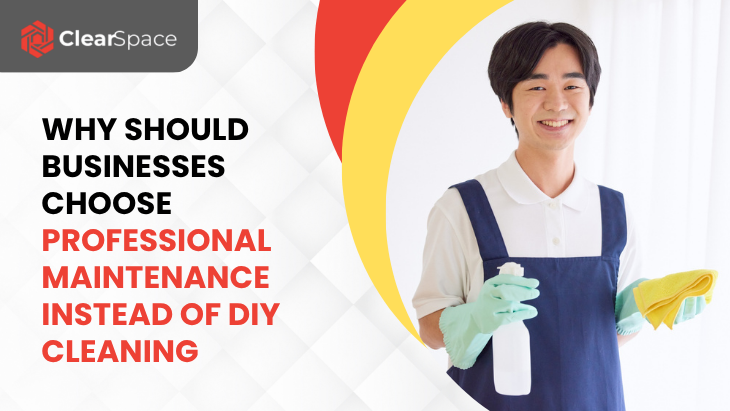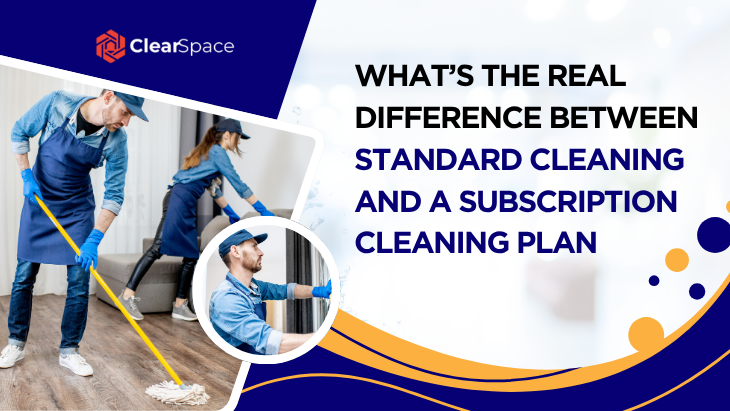Employee productivity is no longer just about task lists and time management, it’s about the environment in which people work. As companies compete for talent and strive to maintain a competitive edge, workplace strategy has emerged as a critical tool for enhancing both performance and employee satisfaction.
Workplace strategy is about intentionally designing and managing your office environment to support your people, culture, and business goals. It connects the dots between space, technology, processes, and people, resulting in workspaces that are efficient, engaging, and impactful.
Beyond furniture and floor plans, workplace strategy also involves maintaining the functionality and hygiene of the environment itself. In today’s era, Trusted Cleaning & Device Repair Services are essential elements of a high-performing workplace, ensuring employees feel safe, supported, and free from unnecessary disruptions.
At ClearSpace Inc., we help companies design workplaces that aren’t just beautiful but strategic, data-driven, and aligned with business objectives. This blog explores how workplace strategy influences productivity and why every organisation should invest in it.
Understanding Workplace Strategy
Definition and Purpose
Workplace strategy refers to the deliberate planning and design of the work environment to enhance business performance and employee experience. It’s not only about how the space looks, it’s about how it functions and evolves with the organisation’s needs.
The goal is to create an office environment that supports a company’s people, processes, and priorities. When executed well, workplace strategy can dramatically improve how work gets done.
Core Elements of a Good Workplace Strategy
A strong workplace strategy is built on several key components:
- Space planning: optimising layout and utilisation
- Technology integration: ensuring seamless access to digital tools
- Employee needs: understanding work styles and wellness requirements
- Flexibility: allowing for evolution over time
- Culture alignment: reflecting company values through design
Common Myths and Misconceptions
Some believe workplace strategy is just about aesthetics or that it only applies to large corporations. In reality, it’s equally important for small businesses and startups, and it focuses on performance as much as style.
Another myth is that strategy is “one and done.” Effective workplace strategy is ongoing it adapts as teams grow and business goals shift.
The Connection Between Workspace and Productivity
How the Physical Space Impacts Mental Flow
The layout, lighting, acoustics, and overall vibe of a workspace have a direct impact on how people think and feel. Natural light, clean air, ergonomic furniture, and well-zoned areas can enhance concentration and reduce fatigue.
On the other hand, cluttered spaces, constant noise, or lack of privacy can derail even the most focused employees.
Productivity Killers in Poor Workplace Designs
Without a strategic approach, workspaces can fall victim to:
- Distractions from open-office noise
- Lack of breakout spaces for creative thinking
- Poor ergonomics leading to physical discomfort
- Inflexibility that doesn’t support hybrid or team-based work
These elements sap energy, lower morale, and create friction in day-to-day operations.
The Psychology Behind Productive Work Environments
Psychologically, people perform best when they feel supported, autonomous, and connected. Workspaces that offer choice and control, foster collaboration, and promote well-being naturally enhance productivity. Simple choices like access to quiet areas or personalisation options can make a big difference.
Modern Trends in Workplace Strategy
1. Remote and Hybrid Workforces
Hybrid is here to stay. In response, companies are crafting workplace strategies that support both in-office and remote employees, ensuring equal access to tools, communication, and collaboration spaces.
Hot-desking, virtual collaboration zones, and shared digital platforms are now essential components of workplace strategy.
2. Flexible Layouts and Activity-Based Workspaces
Gone are the days of static desks. Today’s offices support a range of activities heads-down work, brainstorming, informal chats, and formal meetings. Designing spaces with purpose-built zones lets employees choose where and how they work.
3. Use of Technology in Workspace Optimisation
Sensors, analytics, and integrated platforms provide insights into how space is used. This data enables companies to adjust layouts, reduce wasted space, and optimise work environments based on actual behaviour.
Benefits of an Effective Workplace Strategy
Boosted Morale and Engagement
A thoughtful workspace shows employees they’re valued. When people feel their needs are considered, be it through comfortable seating, quiet rooms, or accessible design, they’re more likely to be engaged and loyal.
Better Collaboration and Communication
Strategic design fosters both spontaneous and scheduled collaboration. Open lounges, brainstorming zones, and tech-enabled meeting rooms help teams work more cohesively and creatively.
Reduced Turnover and Burnout
High-performance spaces reduce friction and fatigue. When employees have the right tools and environments, they’re less likely to burn out and more likely to stay long term.
How to Build an Effective Workplace Strategy
1. Assessing Current Performance
Start by evaluating what’s working and what’s not. Gather data on space usage, employee feedback, and productivity metrics. This baseline helps shape design decisions grounded in real needs.
2. Involving Employees in Planning
Your team knows best what they need. Use surveys, workshops, or pilot programs to co-create a workplace strategy that reflects their input and preferences.
3. Aligning Strategy with Company Goals
Your workplace should reflect your mission and operational priorities. Whether you prioritise innovation, efficiency, or collaboration, the design must align with those values.
Real-Life Examples of Workplace Strategy in Action
1. Google’s Office Philosophy
Google is known for its playful, employee-first design. From nap pods to innovation labs, every space is crafted to support creativity and collaboration, a clear reflection of its workplace strategy.
2. Microsoft’s Focus on Hybrid Enablement
Microsoft has embraced hybrid work by rethinking its office design. It offers flexible workstations, AI-powered meeting rooms, and digital tools to connect remote and in-office teams.
3. Startups That Nailed the Workspace Game
Smaller firms are also leading the way. Many startups are using co-working models, resimercial design, and modular setups to maximise flexibility while staying budget-friendly.
Challenges in Implementing Workplace Strategy
Budget Constraints
Strategic workplace redesigns require investment. But with proper planning, businesses can prioritise high-impact changes first and implement incrementally.
Resistance to Change
Employees can be sceptical about new layouts or rules. Clear communication, involvement in planning, and phased rollouts help build trust and minimise disruption.
Balancing Different Employee Needs
Every team and individual has different needs. The challenge is designing inclusive spaces that offer flexibility, privacy, and accessibility for all.
Conclusion
Workplace strategy is no longer a luxury, it’s a necessity. The physical environment has a profound impact on how people work, feel, and perform. From layout and lighting to technology and culture, every element should be designed with a purpose.
By embracing a well-thought-out workplace strategy, businesses can enhance productivity, boost morale, and prepare for the future of work. And in this strategy, the basics matter too, things like Trusted Cleaning & Device Repair Services ensure that your environment remains reliable, healthy, and disruption-free.
At ClearSpace, we don’t just design offices, we craft experiences that empower people and enable business growth. Whether you're rethinking your current space or planning a new one, we're here to help you strategise with clarity and confidence.
Ready to make your workspace work for you? Let’s connect and start building a smarter, more productive future.





Leave a reply